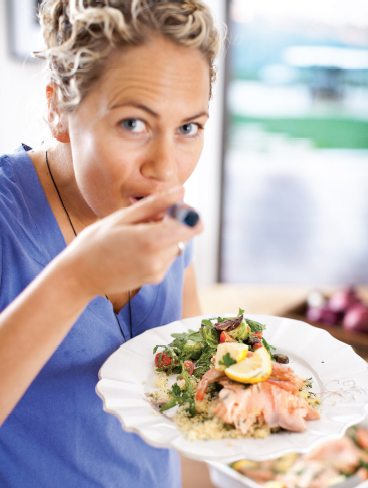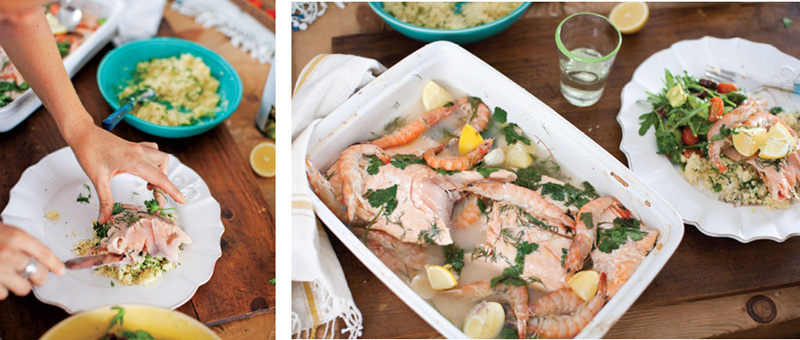
{ Serves 4 to 6 }


Poaching is a wonderful way to cook fish because it’s completely gentle and stress-free, so the result is a beautifully delicate piece of fish. This dish is full of its own natural flavor because the salmon poaching liquid is used to cook the shrimp and couscous. It’s also a really easy dish to make and great for a dinner party when you want to make it seem special but not have to do too much.
I love to serve this dish with a very simple but delicious Avocado, Arugula, and Spinach Salad, but it can go with anything you like.
1/2 bottle good sauvignon blanc or other white wine
2-pound side of wild salmon (ask your fishmonger to debone a side, and skin it too, if you like)
2 garlic cloves, roughly crushed with the back of a knife
1 handful fresh dill leaves
1 handful fresh parsley leaves
1/2 Meyer lemon, cut into wedges
Maldon or other flaky salt
Freshly ground black pepper
Extra virgin olive oil
1/2 pound shrimp, shelled and deveined
1 heaping cup uncooked couscous
Zest of 1 lemon
1 handful mixed fresh herb leaves (such as parsley, dill, and mint), three-quarters roughly chopped and one-quarter reserved for garnish
1. Preheat the oven to 300°F.
2. To make the poaching liquid, pour the wine and ½ cup water into a baking dish large enough to hold the salmon and add the garlic, dill, parsley, and lemon wedges. Season with salt and pepper and give it a little taste to make sure you can taste the salt.
3. Place the salmon in the baking dish. It should be almost completely submerged, though if a bit of the surface is exposed, it’s fine. Drizzle a little olive oil over the top and season with a little more salt and pepper. Bake for 10 to 12 minutes, until the fish looks about halfway cooked.
4. Add the shrimp to the baking dish and make sure they are fully submerged around the salmon, then return the dish to the oven for another 8 minutes or so. Important: You don’t want to overcook the shrimp. You’ll know they’re cooked when they become opaque instead of translucent, but if you’re not sure, take one out and pull it in half to check. Just remember that it should be delicately poached and tender when it’s done, not undercooked and certainly not tough. As for the salmon, I like mine a little rare in the middle, but you can cook yours through; just take special care not to overcook. The easiest way to test for doneness is to pull the salmon out of the oven and gently press down on the middle of the fillet with your fingertips. When it’s perfectly done, it will give way in the shape of flakes. Raw feels, well, raw, and overcooked feels firm and tight. When it just starts to fall apart from a gentle prod, you’re good.
5. Remove the baking dish from the oven, take ½ cup of the beautiful hot poaching liquid, and add it to a bowl with the couscous. Cover the salmon with aluminum foil to keep it warm, and cover the couscous with plastic wrap. Let the couscous sit for 5 minutes, or until all the liquid is absorbed and the couscous is tender. Fluff the couscous with your fingertips and add the lemon zest and the chopped mixed herbs.
6. To serve, spread the couscous out on a serving platter and carefully place the salmon in the middle of the plate. The trick is to lift the salmon out slowly! If possible, ask someone to help you by using a couple of spatulas and working together. To finish off the dish, spoon over some of the extra poaching liquid and garnish with the remaining herb leaves and the cooked Meyer lemon wedges.
NOTE: If you’re not going to eat the salmon with the couscous, let the fish cool down a little in the stock and then lift it out onto a platter. Throw some fresh herbs over the top and serve. Or cool, refrigerate for up to a couple of days, and serve it flaked on a salad or pasta.




